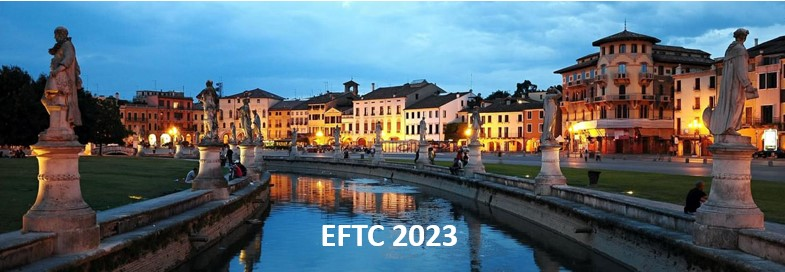Speaker
Description
Importance of Parallel Dispersion in ICRF Modelling of Travelling Wave Antenna Concept in DEMO-Like Plasmas in 2D Axisymmetry
B. Zaar$^1$, T. Johnson$^1$, L. Bähner$^1$, R. Bilato$^2$, R. Ragona$^3$, and P. Vallejos$^4$
$^1$KTH Royal Institute of Technology, Stockholm, SE-114 28, Sweden
$^2$Max-Planck-Institut für Plasmaphysik, Garching, D-85748, Germany
$^3$Department of Physics, Technical University of Denmark, Kgs. Lyngby, DK-2800, Denmark
$^4$FOI Swedish Defence Research Agency, Norra Sorunda, SE-137 94, Sweden
Radio-frequency waves in the ion cyclotron range of frequencies (ICRF) in fusion plasmas are often modelled using the finite element method, spectral methods, or a combination thereof. Due to spatial dispersion, which is a non-local effect, the propagation and in particular dissipation of ICRF waves in fusion plasmas are best represented using spectral methods, since the wave-particle interaction is naturally described in Fourier space. However, spectral methods are inefficient when trying to accurately describe the complex geometries of the antenna and vessel wall, which are important for the power coupling to the plasma. Here, the finite element method is better suited. It has previously been shown that non-local effects can be added iteratively to a finite element solution [1], accounting for both parallel [2, 3] and perpendicular [4] spatial dispersion. Doing so, it is possible to use realistic geometry for antennas and vessel wall, while retaining the main plasma wave physics in the core plasma.
In this work, we follow the method described in [3] to determine the importance of parallel dispersion when modelling the travelling wave antenna (TWA) in a DEMO-like plasma [5] using a second harmonic tritium heating scheme. The proposed TWA for DEMO is an attractive antenna concept that can couple high power at lower voltages, allowing for longer distances between the antenna elements and the plasma boundary. ICRF waves launched from different positions will have different poloidal spectra and will be more or less susceptible to parallel spatial dispersion. To investigate this dependence, the antenna will be placed in a few different positions. An example of a top-launched ICRF wave is shown in Figure 1. Since iterative solutions may be computationally expensive, we also compare the iterative solution to a local plane wave approximation of the poloidal contribution to the parallel wavenumber, as an alterative way to estimate the effect of parallel dispersion.
This work has been carried out within the framework of the EUROfusion Consortium, funded by the European Union via the Euratom Research and Training Programme (Grant Agreement No 101052200 — EUROfusion). Views and opinions expressed are however those of the author(s) only and do not necessarily reflect those of the European Union or the European Commission. Neither the European Union nor the European Commission can be held responsible for them.
References:
[1] D. L. Green, and L. A. Berry, Computer Physics Communications 185, 736-743 (2014)
[2] O. Meneghini, et al., Physics of Plasmas 16, 090701 (2009)
[3] B. Zaar, et al., AIP Conference Proceedings (in press)
[4] P. Vallejos, et al., Plasma Physics and Controlled Fusion 62, 045022 (2020)
[5] R. Ragona and A. Messiaen, Nuclear Fusion 56, 076009 (2016)
